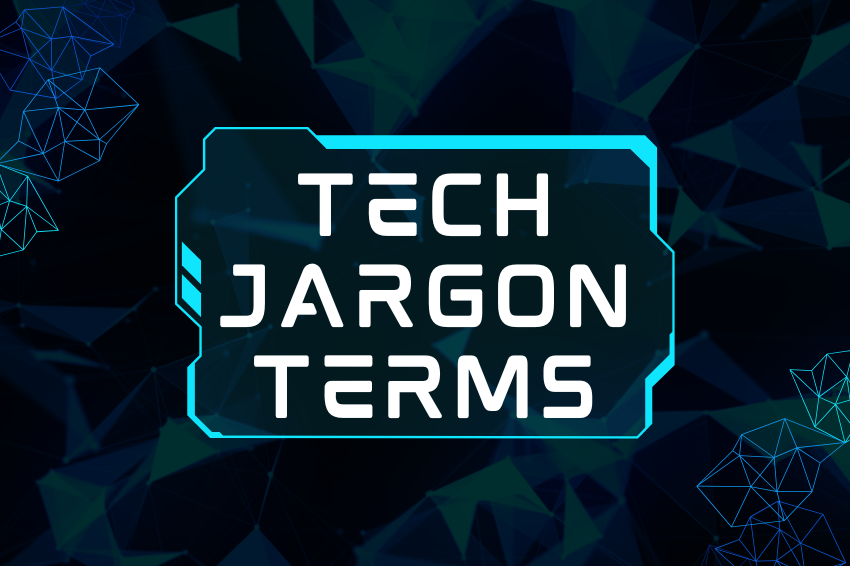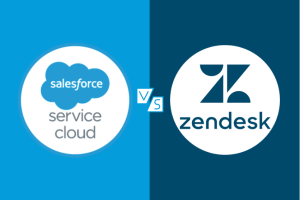Technical advancement stays rapid so it produces an enlarging number of specialized tech terms which create confusion even for experienced technical professionals. Some terminology is straightforward to understand yet other tech jargon terms mysterious rather than professional terminology.

The comprehension of these tech jargon terms extends beyond engineering and development to business management and entrepreneurial determination because smart digital decisions require informed leadership. These tech jargon terms represent both disruptive innovations and high-performance data querying abilities which are essential knowledge for everyone.
Tech Jargon Explained: 11 Terms You Need to Know
The following list contains new tech jargon terms which everyone should understand to grasp the virtual world better.
Disruptive Technology
People often use disruptive technology as a business buzzword although you need more than this semantic definition to understand it. The essential definition of disruptive technology identifies innovations which transform industry operations by replacing established products, business models or services with better efficient and accessible solutions that also deliver cost-effectiveness.
Streaming services like Netflix demonstrated how well their new model could disrupt traditional cable television businesses while ride-sharing platforms for example disrupted conventional transportation infrastructure. Disruptive technology serves as a perfect example because disruptive solutions transform entire industries while going beyond incremental value improvements.
Businesses leading the implementation of new technologies stand to outperform their competitors, contrary to those organizations that avoid technological adoption. The detection of disruptive technology depends on finding revolutionary solutions that oppose traditional procedures.
Snowflake Query Performance Matter
All professionals working with data analytics as well as cloud computing and business intelligence projects need to understand the importance of Snowflake query performance. Snowflake sets itself as a cloud-based data warehousing solution that handles voluminous data along with features for scalability and security and operational efficiency. What makes the query performance of Snowflake so important?
Running queries across extensive database quantities proves sluggish and resource-exhaustive in ordinary database architecture. The optimized design of Snowflake makes its query processing distribute workloads effectively allowing businesses to receive fast insights by requiring minimal computing resources. Real-time analytics depends heavily on this decision due to the importance of those sectors including finance healthcare and e-commerce.
Destinations that understand query performance elements in Snowflake become capable of managing both their data costs and real-time decision-making through optimal data processing. The competitive edge for businesses depends on their ability to enhance Snowflake query performance since they depend on high-speed analytics.
Edge AI and Why It’s Changing the Game
The current transformation of business operations through artificial intelligence reaches its next stage due to Edge AI. Edge AI functions differently from conventional AI systems since it handles information processing directly on the location of use rather than sending data to central cloud servers.
Real-time decision-making requirements trigger major benefits for various industrial sectors. Self-driving cars demand instant traffic data processing because they cannot afford to wait for replies originating from the cloud.
AI-powered sensors enable real-time optimization of smart factory production lines through their smart factories’ operation. Edge AI technology directly provides medical diagnosis tools to portable healthcare devices which now give patients faster diagnostic results.
Zero Trust Security
The number of cybersecurity threats continues to advance daily by becoming more complicated and demanding updated security models for businesses to protect against them. The security solution Zero Trust Security serves as a contemporary system that rejects trust for all users and devices at the corporate firewall gateway.
Traditional cybersecurity models base their belief on the premise of network access authorization even though it does not mean absolute system trust; they can be trusted. Zero Trust security makes users and devices prove their authenticity all the time even though they are inside trusted internal networks.
A company’s operations must integrate security protocols which include multi-factor authentication together with identity checking and instantaneous security tracking at every operational stage.
Quantum Computing
Quantum computing stands today as the most complicated transformative advancement of modern technological progress. The computational processing of quantum computers operates differently from traditional systems since traditional computers deal with bits but quantum computers employ multi-state operating qubits. These systems execute calculations much speedier than traditional computers would need centuries to finish.
Quantum computing technology is beginning its development but it has the power to transform whole industrial sectors which demand enormous computational capabilities. Financial institutions could leverage this technology to conduct-risk evaluation while pharmaceutical companies could achieve rapid drug development through it and logistics operations could fully optimize global networks.
Businesses handling extensive data operations need to monitor the development of quantum computing since the research remains exclusive to labs at present. Future advancements to this technology will transform what can be achieved in artificial intelligence development as well as climate pattern forecasting.
Businesses that begin exploring quantum computing possibilities in their operations today will obtain the greatest capabilities to capitalize on this disruptive technology when it reaches widespread adoption.
Blockchain
Blockchain is electronic and digital system of recording of transactional data in a distributed network. Thus, each transaction has to be clear and non-adjustable, which means that once data are recorded in the system, they cannot be changed. Although people mainly know this technology since the famous Bitcoin, it has so much more use cases.
A blockchain can help in protecting supply chain, identifying goods, and in smart contracts where terms of the contract are coded into the computer program. Of the four features of blockchain, decentralization helps in minimizing the risk of fraud since there is no central point of control entailing more trust between partakers.
Further, it is evident that blockchain technology has the advantage of being secure and transparent in the handling of data. For example, it can contribute to the healthcare sector by making patient’s records secure from other unauthorized people, but at the same time, it can be accessible to doctors or other medical staff when needed.
In finance, it can help in quick realization of cross border payments, through reduction on agents. Based on the attributes such as the scalability and versatility of blockchain, the technology could readily find application in tracts of several sectors such as government, real estate, energy among others, thus making it a fundamental part of the digital economy.
Internet of Things (IoT)
As an abbreviation for Internet of Things, it is the comprehensive system of tangible objects such as devices, vehicles, spaces like buildings, and products that are connected with sensors, software as well as several network connections to collect and share information. This interconnectivity therefore fosters smooth sharing of information leading to optimization of the systems used for greater productivity.
For example, an intelligent thermostat can learn the pattern and control the temperature based on the ‘pattern’ of an individual to ensure that energy is conserved. Likewise, empower therapeutic tools in the healthcare domain can also track the body signs and trends in real-time thus helping the medical practitioners consider appropriate necessary intervention in case of worsen situation.
IoT technology is being responsive to industries in a way that is improving automation and the ability to make business decisions based on data and analytics. In the manufacturing context, corporate IoT can track the productivity of equipment devices to determine when they require to be repaired to ensure it does not take time.
In the agricultural corner, temperature, humidity, and soil moisture can be put into consideration in order to improve irrigation schedules for improved production. IoT solutions are being used in delivering services which supports smart city services based on connected transport infrastructure that help in managing traffic, energy conservation and safety.
Artificial Intelligence (AI)
Artificial Intelligence is described as a number of concepts which make systems perform human-like operations and capacities. Some of the cognitive tasks include learning, reasoning, problem solving, perception and understanding of language.
AI systems can be narrowed or weak if they are designed for particular work; they can be general or strong if they are able to solve any problem which a human is able to do. Machine learning in particular is a component of artificial intelligence where the input data feeds algorithms and the latter makes a decision or a prediction.
Through moving through many industries, automating parallel and efficient processes, and supplying information that was once unimaginable to get. In the case of health care, AI can diagnose diseases from images with less error and this helps to diagnose the diseases at an early stage. This is the case in finance whereby an algorithm can gauge market trends and investment to select an appropriate portfolio for the client.
As you know now, smart home devices such as Siri and Alex, that are a fundamental part of our life, and make work and search for some information much easier. With the sophistication of AI, the potential for creating new value across most areas of life grows apace, to an environment where men and machines work hand in glove.
Cloud Computing
Cloud computing is therefore the practice of using one’s computing resources, software and services through Internet connection rather by local access. This way, various companies and independent individuals can use technological resources, without having to spend much on the physical means of computing devices and software.
These are commonly in the form of service models, which allow clients to pay on subscription basis to suit their demand. There are basically three major cloud network service providers in the industry that are AWS, Microsoft Azure and GCP and these three offers numerous services for meeting business needs.
Cloud computing services have become common in every business today since its implementation has greatly transformed the operation of organizations. It supports working from home by allowing people to access applications and data on the network from any location and increase collaboration.
Another flexibility of cloud computing is that it provides the best solution for disaster recovery and the continuity of business. Further, it assists in decision making since it enables businesses to implement new applications much faster and at a lesser cost. It can easily become very important if it continues to develop in the course of the future of many industries, for instance, AI, IoT and blockchain to fuel digital transformation.
Machine Learning (ML)
Machine Learning or popularly known as ML is one of the subsets of Artificial Intelligence where the algorithms and statistical models allow the computer to learn from the data and make the decision accordingly.
ML is different from other traditional programming paradigms that require a programmer to write instructions for the computer, how it should behave in response to certain inputs and reaction in response to such stimuli.
There are basically three classes of machine learning which are Super vectors or supervised learning, unsupervised learning and reinforcement learning. Presently, ML uses data to drive innovation in many fields, through helping a system to learn from data.
In the retail business, through machine learning algorithms, you can have the ability to understand the behavior of the customers so as to suit their needs and also in organizing the products on the shelves. In the field of healthcare, it is capable of predicting patient care outcomes to diagnose diseases by analyzing physician records and imaging.
Finally, it is worth mentioning that NLP is one of the key areas in the modern ML agenda, making chatbots and voice assistants smarter. Due to the increase in data availability, potential and uses of using machine learning are also expected to increase more as a way of enhancing innovation and functionality.
Software as a Service (SaaS)
SaaS is another cloud delivery model where software applications are remotely, centrally located and centrally accessed by users through the internet. As opposed to traditional programs that are installed on a particular device, SaaS applications are run on a web browser, thus the user will not need to constantly upgrade his/her device or the software in the same.
It is such a model where the users can access the software and use them through payment plans without having to purchase the software. It is evident that SaaS solutions are applicable in many sectors, and it is used in customer relation management (CRM), project management, and enterprise resource planning (ERP).
SaaS has revolutionized the software deployment model and usage in various organizations and companies. It allows organizations to provide their IT resources in a proportional manner, to unforeseen needs in the business environment, thereby making a company not to invest an awful lot of money in infrastructure. The SaaS providers take responsibilities for all maintenance aspects inclusive of upgrading, protection and backups leaving the corporations to effectively handle their central activities.
Furthermore, SaaS supports teamwork since everyone can access the applications and information in real-time irrespective of location as well as for remote working or virtual teams. Therefore, SaaS can be viewed as the primary driver of cloud solutions in the future as it is widely expected to continue the process of digital transformation with new efficient solutions that will actively improve the overall business outcomes and competitive advantage.
Conclusion
It is important to know these tech jargon terms but is about memorizing those words, not understanding which ideas are behind those terms and how such terms change the modern society. Thus, it becomes apparent that language also develops contingently with technology which is ever changing at present. You now know the most essential tech jargon terms for engaging more effectively with the technology sphere as a professional, a student or just an enthusiastic user.


